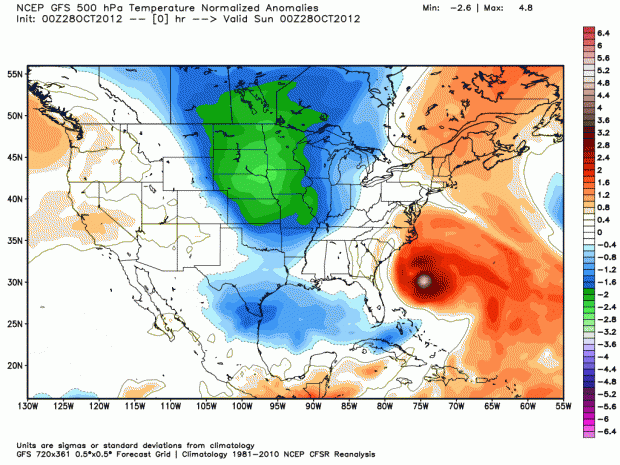 As Hurricane Sandy heads our way, and the city battens down the hatches for Frankenstorm, we’re thinking about home damages in natural disasters. In 2011, Hurricane Irene caused $15.6 billion in damages in the U.S., and according to most reports, we can expect Sandy to surpass that figure.
As Hurricane Sandy heads our way, and the city battens down the hatches for Frankenstorm, we’re thinking about home damages in natural disasters. In 2011, Hurricane Irene caused $15.6 billion in damages in the U.S., and according to most reports, we can expect Sandy to surpass that figure.
If you live in NYC, Jersey, or anywhere else along the path of the storm, we have some advice.
First, get yourself safe, and evacuate if you’re told by local officials. Then, create a home inventory of your stuff. If you have a renter’s or a home owner’s insurance policy that covers flooding or hurricane damages, you’ll be glad you did. 20 minutes spent creating a record of what you own and the condition of your stuff before the storm hits can go a long way in substantiating damage claims and save you thousands of dollars in the aftermath of a natural disaster.
To be clear, Moveline’s not an insurance company, but we do know a few things about home inventories.
Here are our tips for doing it right:
Detail is your friend
We recommend filming a video tour of your place, because the more detail you capture about an item, the better your chances of seeing a payout. Walk through each room in your place, and talk about items as they come into frame. Describe the item, noting things like where you bought it and declare a value for it before moving onto the next. Be especially thorough with items that are prone to theft or damage, or of high value, including flat screen TVs, antiques, and collectibles.
Document everything
Everything you own has a replacement value — the cost of replacing an item in its current condition. Your clothing, car parts in the garage, dishes, and furniture may not be worth much individually, but when you add it all up, it’s a huge expense to buy these things new.
Store the inventory in the cloud
Your records can’t help you if it’s kept on a hard drive or in a filing cabinet that floods. If you already have an inventory on hand, transfer it to Dropbox, iCloud, or Google Docs so you know the files are safe. If you don’t have one yet, you can film one using Moveline’s iPhone app, which will automatically sync the files to a secure AWS server in the cloud.
For tips on how to film a home inventory, check out our Video Instructions. Most of all, good luck with Frankenstorm, and be safe.
Image credit: Weather Bell via The Atlantic.
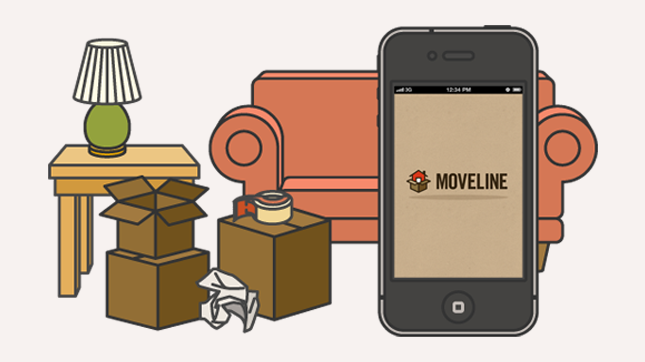 The first version of our iPhone app is here. You can read news about its release in TechCrunch, check out the features here, and download it in the App Store. In Moveline for iPhone, we’ve built a new product that improves the otherwise painful experience of moving, and launched an idea that changes the moving industry for the better, and forever.
The first version of our iPhone app is here. You can read news about its release in TechCrunch, check out the features here, and download it in the App Store. In Moveline for iPhone, we’ve built a new product that improves the otherwise painful experience of moving, and launched an idea that changes the moving industry for the better, and forever.
Bringing the moving process into a new era
In 2012, we can buy a car without visiting a dealership, and hail town cars from our smartphones. Still, we can’t get a worthy estimate for a move without giving up the lunch hour for a sales call. The way we shop for everything else has evolved — moving hasn’t kept up.
For the first version of Moveline for iPhone, we’ve started with a fresh take on the home inventory: the first, most critical step in working with a moving company.
Home inventories in the dark ages
The most powerful information about a move is the customer’s inventory — the list of stuff they have to move. This list is infinitely useful to moving companies. From it, they can determine how much space the customer’s things will take up on a truck for interstate shipping, how many boxes they’ll need to pack everything, and what kind of services will be required on the job. More importantly, it helps them decide how many people they’ll need to perform the move, how long it will take, and how much to charge for their services. Because this information is so important, most moving companies require a home inventory before giving their customers a quote on their move.
To date, the practice of creating home inventories has remained stale and unfriendly to customers. Good moving companies send a salesperson to the customer’s home to create the inventory by walking through each room, writing down each item that has to be moved, and estimating the boxes needed to pack smaller stuff. These appointments are a time-sink for customers, not to mention the awkward experience of watching a stranger walk through their place and open cabinets. By the end of the visit, they still only have one quote on the table. To compare prices from 3 moving companies (as savvy consumers should), they have to repeat this 3 times.
It’s expensive for moving companies to keep an army of sales people in the field, so some companies cut corners and let customers list their stuff over the phone. It’s less hassle, but also dangerous: because the estimator on the other line can’t actually see the stuff the customer has to move, details get lost that otherwise factor into the estimates. Phone inventories are notoriously inaccurate, and since everything is based on faulty data, they often lead to customers paying more and experiencing sloppy moves.
Finally, there’s an app for that
Our goal was simple. We aimed to create a product that gives people an easy way to get prices from several moving companies based on a single inventory — one that gives movers the information they depend on to plan and execute a quality move.
Mobile video for efficient, accurate inventories
We’ve taken advantage of the advancement in smartphone tech and faster bandwidth to finally do visual home inventories at scale without compromising detail.
Using Moveline for iPhone, customers can shoot a quick room-by-room video tour of their place, or connect with one of our Move Captains using video chat to show us the stuff they’d like to move. We see the same things salespeople see when they walk through a customer’s home, without the cost or invasion of on-site visits. Based on the footage, our in-house team of trained estimators create the customer’s inventory using software we’ve spent years developing based on data from hundreds of past moves. When they’re done, they send the inventory back to the customer to make decisions about which things to take with them, what to put in storage, or leave behind, and let the customer control the inventory from there.
One inventory. One estimate. Apples-to-apples price comparison
When customers have finalized their inventory, they can submit it back to Moveline for quotes. We strip the move of any personally identifiable information about the customer, and shop it around to the best moving companies in town to get competitive quotes, all based on the same information. We screen our network of moving companies heavily for quality; only approved providers can bid on Moveline jobs.
Using Moveline, customers get to review 3-5 quotes (depending on providers’ schedules) from moving companies all at once. These prices are guaranteed. As long as the inventory and the other job details stay the same, the prices they see for the move are exactly what they’ll pay.
Feedback so far
The app is just now available for download by the public, but we’ve been live doing video and FaceTime inventories since June (to early users who sent videos via Dropbox, thanks for your patience) and been beta testing the app on live moves for the past few weeks. What we’ve heard from people who’ve used it has surprised even us.
Customers love our inventory process because:
- It saves time. They can skip the in-home visits, spend 15-20 minutes filming their place, and they’re done.
- They’re not dealing with pushy salespeople. They decide based objective information and compare prices straight.
- It’s private. Contact info and videos are never shared outside Moveline, which means no unwanted calls.
- They trust the results. No of second-guessing their own box estimates using online inventory forms, they have confidence knowing that the inventory was created by an expert.
The moving companies we work with love it because:
- They believe the numbers, because they’re based on a visual survey.
- They provide all the information needed to prepare the crew for a solid move.
- Business comes to them. No need to send salespeople to quote, they just report the price.
Coming up next
This app is our first foray into mobile, but there’s more to come. We’ll be adding more features to the app over the coming months to make it useful in other stages of the move. We also have plans to extend the app to other platforms in the future. Until then, Moveline customers who don’t own an iOS device can still connect with us over other video chat platforms like Google Hangout and Skype.
For now, we’re excited about the app’s release, and look forward to receiving feedback, fixes, and feature requests from the first wave of downloads so we can make it even better.
If you’d like to know more about the app, or have suggestions to make it better, drop us a line at support@moveline.com. We’d love to hear from you.
Ready to move? Build your move inventory today with Moveline.
On Monday, we hosted a NYC Real Estate Technology Startups meetup at the TechStars NYC office. It was the group’s third meetup, and its largest yet. We started with networking over beer and pizza, where the founders of fledgling startups like CompStak, DoorMates, RealDirect and RentHackr were in full force. The offline world was also represented, with brokers from Citi Habitats and executives from Level Group(http://www.levelgroup.com) present.
We then moved into demos.
Fred Cook, co-founder of Moveline, started by breaking down the moving industry. He spoke to familiar problems like the pain of arranging in-home estimates, notoriously poor customer service, and bomb-dropping hidden fees. Next, he demoed Moveline and presented how we solve these common problems using software like our video inventory app and seriously great service from Move Captains. Fred wrapped with hints at features in our pipeline that improve our system for delivering guaranteed prices.
 Laura Temel, CEO of PadTies followed Fred. Laura explained that listings for off-campus housing in college towns remains offline. PadTies is bringing this inventory to the web and introducing optimized tools for student rentals. They offer a rental management application that allows students (or their parents) to pay rent online, and keep track of sublets and security deposits because, well punching holes in walls… it happens in off-campus housing. PadTies is currently open to students at Cornell.
Laura Temel, CEO of PadTies followed Fred. Laura explained that listings for off-campus housing in college towns remains offline. PadTies is bringing this inventory to the web and introducing optimized tools for student rentals. They offer a rental management application that allows students (or their parents) to pay rent online, and keep track of sublets and security deposits because, well punching holes in walls… it happens in off-campus housing. PadTies is currently open to students at Cornell.
Sebastian Delmont and Jared Kleinstein of StreetEasy, CTO and “Mr. Manager” respectively, rounded out the evening. The duo took us on a tour of StreetEasy behind the paywall, and shared stories of the company’s history spanning back to 2007. They highlighted the application’s extensive set of premium tools for real estate professionals, which includes recorded sales information for units and buildings, broker profiles, folders, and a really neat feature that lets user search by custom boundary (because we all know how drastic of a change one can see in NYC real estate by walking just one block). They also showed us StreetEasy’s Own Your Home blog, where they showcase home and real-estate articles written by domain experts. Historically, the company viewed itself as an unbiased source of information. The new blog is the company’s first foray into expressing an opinion on the market. Bottom line: visit StreetEasy for all things NYC Real Estate.
Overall, the meetup represented the vibrant Gotham real estate tech community and its collective efforts to improve how New Yorkers rent, buy and move into a new place.
The next meetup is slotted for October. Stay tuned for an announcement of the schedule — we hope to see you there!
Learn more about how Moveline is creating a radically easier way to move.
In tech circles, it’s common knowledge that “software is eating the world”. In every industry, there are at least a handful of startups who are making the bet that software will revolutionize the way that people make decisions and purchase products and services.
In New York City, real estate is massive. From renting apartments, to purchasing multi-million dollar condos, to all the other services (such as moving!) that people need during this transition, consumers, businesses, realtors and brokers are increasing using software to perform these tasks.
If you’re in New York City this Monday, come by TechStars NYC for the NYC Real Estate Technology Startups Meetup to meet the entrepreneurs who are building the future of real estate. Moveline is hosting, and providing food and drinks.
See presentations by myself (@frederickcook), representing Moveline, Laura Temel (@lauratemel) of PatTies, and Sebastian Delmont (@sd) of StreetEasy.
If you aren’t in NYC, follow along at @nycrets or #nycrets.
Learn more about how Moveline is creating a radically easier way to move.
 Before you turn in your keys and collect your new ones, have you taken care of these errands?
Before you turn in your keys and collect your new ones, have you taken care of these errands?
Shut off utilities
Whether you rented or owned your previous home, if the utilities are in your name turn them off and/or get them transferred before leaving. To be safe, set the shut-off for the day after you leave and turn them on a day before you arrive. This way, you’ll never be without what you need.
Take out (all) the garbage
This is more about karma than anything else; do unto others and all that good stuff. If you have a lot more than your usual load, contact your provider to make sure they can pick it up on trash day. Some cities charge additional fees for discarded furniture and extra bags you have at the curb.
Wash your clothes
Why pack dirty things? This will be just another thing to take care of while unpacking, and you might not know where to do your laundry yet. It’s also hard to remember which clothes are clean and which ones are dirty by the time you unpack.
Forward your mail
You might know you’re moving, but your bank and magazine subscriptions do not. A quick trip to the USPS website and a $1 fee can get your mail to wherever you’re going. Let friends and family know about your new address too.
Check your storage areas
Depending on the size of your home, your storage places might be fairly extensive. Clean out the crawlspace and that weird cabinet behind the stairs. Check the space above your refrigerator — it can be a lurking place for leftover food items. Look through your storage spaces for anything you might have left unpacked. Did you leave clothes in your dresser? Check with your movers to see if this is okay. Some movers prefer to move your clothes in the drawers, other do not allow it.
Do one last sweep through
My mother would make me check under my bed twice before we moved or even left a vacation hotel room, and she was right. Two out of three times there would be nothing, but when I did leave something it would have definitely been missed. Look around for inconspicuous objects like air conditioners and mirrors that you pass by everyday, but might not think about.
Clean top to bottom
Giving your space a good cleaning is crucial, especially when you’re renting. This saves your security deposit and in turn saves you money.
Tackle the chore by starting with one room and work your way through the space. In the kitchen, pay special attention to any counter spaces, cupboards and the refrigerator and freezer, food can leave crumbs and bits behind when stored for long periods of time. When cleaning your bathroom, watch out for the mold that can lurk along the bottom of your shower curtain and in the cracks of the bathtub, as well as any soap residue. Once you finish, top the job off with a good vacuum and dusting. These are the little things you might have neglected, but are sure to deplete your security deposit if taken on by your landlord and a cleaning service.
Sometimes with the best cleaning effort, it’s easy to forget something. Rentals, especially those managed by a third party management company, relish in profiting off the fines they charge on security deposits. $35 to clean the baseboards, $15 for not wiping the ceiling fan blades… it all adds up. If you’re of the “spend money, not time” school of life, try this pro tip: call the landlord and ask which cleaning service they use to make-ready the apartment for new tenants. Hire them; you know they’re familiar with the units and will clean up to management’s standards, and they’re often a little cheaper than your average maid service. Most management companies end up paying for professional cleaning even after you clean. You might as well save yourself the elbow grease when you’ve got forty other items on that moving to-do list.
Check out more moving day tips or move organizing tips from Moveline, a radically easier way to move.
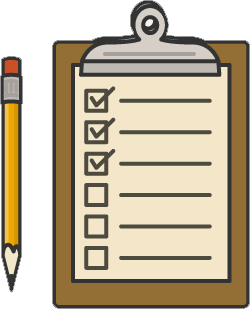 Maintaining your sanity during a major move is tricky. With so many details floating around — the move, the new apartment, the dog’s new vet — it can be stressful trying to keep everything straight. Here are some of our best tips for getting things organized before a major move:
Maintaining your sanity during a major move is tricky. With so many details floating around — the move, the new apartment, the dog’s new vet — it can be stressful trying to keep everything straight. Here are some of our best tips for getting things organized before a major move:
Add key contacts to your phone
Store all the names, numbers, and email addresses of anyone associated with your move, starting with your Move Captain. Beyond that, add info for your crew foreman and the dispatch number for your moving company. Your Captain can always help you get in touch with the movers and coordinate the details, but it’s a good idea to keep these numbers stored where you’ll need them most.
Bookmark addresses and important locations
Which apartment are you moving into again? Where is your nearest Post Office or grocery store? To keep you from constantly searching, pin these spots in one place and build a resource for the next time the question comes up. We recommend Google Maps for this. It’s easy to use, universally recognized, and is a great way to share these locations with other people who might be helping on moving day.
Start a Moving Calendar
Depending on your moving method, you might have several dates and appointments to keep up. When is your container getting dropped off? How long will you be on the road? Should you ship something by a certain time to meet your arrival date? Note things here to keep you on track during the move.
Color Code Your Boxes With Tape
Sharpies are great for labeling boxes, but when it comes time to sort boxes by room, they all look the same. To prevent mixups, it can be helpful to color-code boxes when you’re labeling them so the crew can easily decide where to place them. Several packing tapes come in a variety of colors and styles other than clear plastic. If you have them on hand, try taping neon post-it notes to your boxes using clear tape. This step is especially helpful if you’re moving a large family.
Print out your Inventory
Your inventory list might have gotten you quotes, but it also comes in handy on moving day. During the loading and unloading process, keep your inventory at hand; using the inventory throughout the move to mark things as they get put in storage or unloaded from the truck can be a great way to keep tabs on the progress of your move. If you’re hiring a crew for a long-distance move, the driver will also be documenting the Inventory as items get loaded on the truck.
Keep an “Everything Folder” for Your Move
Before things get hectic, pickup a folder or a large envelope with all your important papers inside of it. This can include your Bill of Lading and other documents you sign such as leases, moving contracts, and insurance declarations. As things get put into boxes, it’s easy to misplace important papers; keep these out and close by for reference or when you need it.
There are hundreds of minor details to keep in mind while moving, but with a little organization upfront, your move will be much easier.
Check out more checklists for moving or pre-move tips from Moveline, a radically easier way to move.
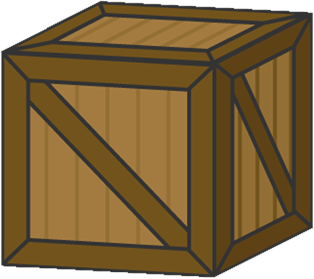 When it comes to packing materials, people usually think of cardboard, bubble wrap and lots of tape. But for your most delicate items, protecting your items in a wooden crate can be an extra insurance that your belongings will arrive safely.
When it comes to packing materials, people usually think of cardboard, bubble wrap and lots of tape. But for your most delicate items, protecting your items in a wooden crate can be an extra insurance that your belongings will arrive safely.
Wooden crates are fit to the size of a fragile or high value item. Because they’re custom built by a carpenter or highly-skilled mover to exact dimensions, crates can be expensive; but when the cost of the crate is less than the replacement or sentimental value of an item, it’s worth it.
More often than not, your movers will recommend crating an item before you know yourself, or you can request one. Requesting a crate is simple enough, but specify that a “wooden crate” when talking to your movers. Moving is all about the small details.
Why should I crate?
Items that are fragile, like glass and marble, might not sustain the handling of a long-distance move and with certain items there’s no hope for repair if damage happens. Crating provides extra protection for the item inside.
Some items that are fragile might also be heavy, so they can cause damage just as easily as they receive it. This might be a factor in your decision to crate. Heavy items can collide with others during a bump in the road; and cardboard boxes and tape can only hold so much. Wooden crates are stronger and better equipped to handle heavy items. Items with sharp edges or corners are also crated — they might puncture a box or rip it, causing the item to come out during the move and damage other stuff on the truck.
What items should I crate?
While not everyone chooses to crate, we see customers opt for crating the following items a lot. Usually, it’s for artwork, particularly canvas pieces, that are ruined if punctured or ripped.
Other items to crate include:
- Antique Mirrors
- Chandeliers
- Taxidermy
- Statues
- Marble Tabletops
- TVs and large electronics
How much does crating cost?
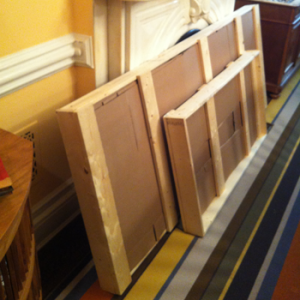 We saw a marble table top and large mirror that had been crated while visiting a move in New York.
We saw a marble table top and large mirror that had been crated while visiting a move in New York.
Crates are not included in most moving quotes; they cost extra. The minimum amount for crating usually hovers around $70. Typically, the movers will measure the size of the item, and build a crate with raw materials. The larger the item is, the more expensive the crate. Most movers destroy crates when the move is over, but if you pay for crating, ask your movers about keeping the crate after your move. This way you can use it again for your next move, and keep it in storage for the next time you’ll need it.
While the cost might deter you, keep in mind the crate could cost less than replacing or repairing any damaged items. Talk to your movers about your options and come up with a game plan for how to transport your belongings safely.
If you have any questions about crating, get in touch. We’ll help you out.
Check out more packing tips and move organizing tips from Moveline, a radically easier way to move.
 Mattresses are often one of the last items in your house that get loaded onto the truck. So when it comes time to move it to your new place, how do you prepare it for safe shipping?
Mattresses are often one of the last items in your house that get loaded onto the truck. So when it comes time to move it to your new place, how do you prepare it for safe shipping?
Different mattresses come with their own needs, and many require effort on your part in advance of the move, so it’s best to plan ahead.
Here’s a guide on how to move your particular mattress:
How to Move a Tempur-Pedic (or other memory foam) Mattress
Did you know that if you store memory foam mattresses on their side for long periods of time, they can crack down the side? Sad, we know, but entirely preventable. While the mattress can be folded temporarily to pivot around stairwells in your four story walk-up, it’s not designed to weather these conditions through a long drive to Dallas or for months of storage in a portable container. Try to ship your memory foam mattress flat, and tell your movers in advance how the manufacturers recommend caring for it. Mattress companies deal with shipping and storage all the time; don’t hesitate to call for specifics.
How to Move a Waterbed:
To put it simply, moving a waterbed means draining and folding it. But draining a waterbed isn’t all that simple; this process can be a little complicated with several steps.
First, remove your waterbed heater, this protects your mattress while draining it. Next, decide on how to drain the mattress. An electric pump can be quick and efficient, and are often rentable. You can also drain it au natural depending on the make. Refer to the instructions that came with your mattress or your provider for details that might be specific to your mattress.
As you’re draining the water, tilt the mattress to get more water out. Roll the mattress like you would a rug. If you’re storing the mattress get a conditioner to prevent mold and bacteria, otherwise it should be truck-ready.
How to Move a Traditional Mattress and a Box Spring:
Storing and moving a mattress on its side is simple enough. However, consider the size of your mattress and whether or not it comes with a box spring. These are two separate pieces that your mover will have to account for. To protect your mattress during the move, look for bags specific to the size of your mattress. Your mover or packing service might have these already. Another option is to use a mattress box, which might provide more protection during a long distance move.
How to Move an Air Mattress:
Simply deflate your air mattress to prepare it for storage. When rolling the mattress, roll it as tightly as possible to prevent any damage. Try to pack it in its original box, as its guaranteed to fit.
How to Move a Sleep Number Mattress:
Similarly to an air mattress, Sleep Number beds must be deflated to prevent damage and boxed properly. The Sleep Number website recommends completely disassembling the base of your bed before moving, though the frame is very sturdy.
How to Move a Futon Mattress:
If possible, remove the cover of your futon mattress before moving. If you can’t remove the cover, find a mattress bag that fits the mattress to protect it from stains and damage. Disassemble your frame (keep track of all the parts!) and keep the mattress flat during the moving process, this keeps interior stuffing intact the way the crafters intended.
When you’re moving, regardless your location or how far it is, consult with your movers before putting your bed in the truck.
Check out other packing tips and move organizing tips from Moveline, a radically easier way to move.
Relocating to a new city for work can be an exciting opportunity at any point in your career. Finding a temporary apartment to rent? Not so much. With all the craziness of traveling, packing and planning, finding a new home is the biggest time suck on the to-do list.
Here’s a round-up of some resources Moveline found that make apartment-hunting easier.
Nestio
Based off a recommendation from Kelly, I signed up for a Nestio account. When tackling the beast that is apartment hunting, make Nestio your righthand website. The site lets you store listings that interest you in one easy place, rather than haphazardly bookmarking them on your browser. As you venture through the following sites, keep coming back to Nestio to keep it all together. It’s especially great if you have to search for apartments with roommates or a spouse; you can invite people to your Nestio to add listings they like, and comment on the ones you’ve found to make collaborating on the search much easier.
RentHackr
RentHackr is a real-estate swiss-army knife. It shows you the real cost of apartments in an area, based on info from real people. Want to know the difference between a studio in Manhattan and a studio in Brooklyn? RentHackr has it. The site even shows apartments held by people who plan on moving soon, details about the unit they’re giving up, and when it’ll be available. As you’re browsing, you can also filter responses based on the rooms you need, when you need to move in (the lease ends slider), and if you’re looking for an apartment or a room share.
We recently caught up with the founder of the New York startup, Zeb Dropkin, to hear about the company. He wanted to give renters the opportunity to see the costs of other apartments in their building, block or beyond and compare them, after Dropkin found the experience painful. “I got really frustrated, why can’t I get this information?”
In the future, users will be able to view photos and other aminities offered by buildings. Until then, it’s worth checking out. Bonus: RentHackr is nationwide, and compares rentals in any location in the U.S. depending on where a user currently lives.
Sublet
Sublet is the website where I found my apartment. The UI might not be the most attractive, but this site has everything you need to find a place, on a worldwide scale at that. Searching can be limited any of the five boroughs, ranges of rent, and more depending on your preference. Reviews and information about the landlords is also available, with some that let you contact them for free. The site does have a paid service that opens all sublet options, and it is worth it. I wish I had found this site before I even opened Craigslist.
Airbnb
Once reserved for short-term trips, Airbnb now offers sublets! When you log into the site, select your arrival and departures dates to browse the thousands of places in your area. Some of the prices might be overwhelming, but a few gems can be tucked away. If you’re in a hurry, you can pay for the security deposit right away and are only charged if the landlord responds to you, thus securing your room.
Craigslist
Craigslist is the quick and dirty option for everything; from buying a desk to finding a roommate. It can also be hectic, confusing and slow, not to mention sketchy. I recommend browsing posts for housing, but it can difficult to find what’s right for you. Instead of competing with all the other searchers, try posting your own ad — for yourself. Create a new post under “Housing Wanted” and be personable in describing yourself and what you’re looking for in a housing situation. When I searched for a place, I got more responses to my own ad than I did from emails I’d sent to others.
Our guide to NYC apartment terminology
In New York City, the lexicon of dwelling types is practically infinite. If you’re considering a move to the Big Apple, we’ve got a simple glossary to help you navigate the maze of apartment options. Check out our nyc apartment terminology guide here.
Moving your stuff into your new apartment
Hopefully these resources will help you take a little bit of the stress out of NYC apartment hunting. Once you’re ready to plan how to move your stuff to your new place, consider taking the stress out of moving by using Moveline to get guaranteed quotes from moving companies for your move to NYC.
Check out other pre-move tips or tips to help you plan for your move from Moveline, a radically easier way to move.
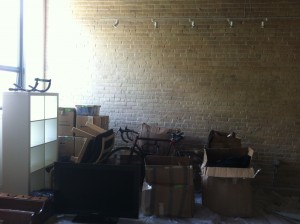 When we caught up with Aaron Arcello, a Moveline customer who recently moved from NYC to Madison, Wisconsin, we were reminded of all the opportunities moving can bring.
When we caught up with Aaron Arcello, a Moveline customer who recently moved from NYC to Madison, Wisconsin, we were reminded of all the opportunities moving can bring.
In August, Arcello will begin working toward his MBA at the University of Wisconsin, where his girlfriend is also studying for her PhD. The two moved in together in Madison and have since been shopping for furniture and experiencing the upper-mid west.
How did this move differ from your previous moves?
“Aside from the actual distance and circumstances, I’d only lived in Rhode Island and New York, so my last three moves were in the City… This one just went way better because I just had a much better handle on it, and I started the process three or four months before the actual move.
“It was also the first move I had done that was just totally by myself. I’d always moved into places with roommates so we were able to split costs. Cost was less important when you’re moving three or four people… I was footing the entire bill.”
Would you do anything differently with your next move?
“I would definitely do the full-service thing again, it’s just such a big difference…
“I hate moving, this is the first move that I’ve done where I haven’t gotten hives… That was the biggest thing for me; the stress was so much lower than all my other moves. Nothing was fun (besides) realizing I wasn’t having a nervous breakdown.”
Would you recommend Moveline?
“I would recommend and have recommended people check out Moveline…
I still like the look and feel (of Moveline.) I think it’s great. It’s very comforting in a situation that is usually very fraught and frustrating and difficult, so I thought that was kind of nice… The inventory was nice to have down on paper, I could look at that and compare with what my girlfriend had and see overlaps in what I should and shouldn’t take, try to sell on Craigslist, leave behind or what we needed to buy. It was nice to have a written record of the things I was moving.”
What else would you recommend for anyone moving?
“As far as making the process easier, the most important thing, I guess, is to give yourself as much time as you can to space out the actual act of packing and organizing.
“Be ruthless in your assessment of what you need to take, and what you can throw away or donate or sell. Move less and take more time organizing and getting everything together, instead of throwing everything together 24 hours before the movers arrive.
What’s your favorite thing about Wisconsin?
“I have to say the beer and the cheese really are good. It’s kind of the cliché response, but they do take it seriously here. It’s cheaper and better here.”
What do you miss about NYC?
“I just miss being able to have access to anything and everything at all hours of the day. I’m not used to things closing at 10, not being able to get a drink or get dinner at 10:30 because all the places are closed. I’m not used to being in a place where things shut down at a certain hour.”
What has been the biggest adjustment getting settled in Wisconsin?
“This is the first apartment I’ve lived in that feels like an adult apartment, where I haven’t been living with friends from college, also the first time I’ve lived with a girl. So we’re taking more of a thoughtful approach to furniture and decorating and things like that. It’s taking a little while longer, but luckily we have a bit of time; our classes don’t start until August, so we have plenty of time to organize things.”
What fun things have you done in Wisconsin?Aaron Arcello takes a look at the new Madison, Wisconsin apartment he shares with his girlfriend.
“We went tubing on the Wisconsin river, that was pretty fun on a hot day. I really haven’t been here very long; I’ve been here five or six days since we got back from Northern Michigan (for a vacation.) We were able to do a cool drive; we drove up through Michigan, across the Upper Peninsula and down to Madison, that was pretty neat.
“I got my student ID, and that was exciting for me. I haven’t been a student in six years. That was a big moment for me, to have my student ID again. We’re right next to campus, our apartment is about a quarter of a mile from campus. I’m just excited to be out here as a student again, I’ve been dying to go back to school for many years. So I’m just excited that I’m at the University of Wisconsin, and just excited for the classes, athletics, everything that goes along with being a student.”
Learn more about how Moveline is creating a radically easier way to move.